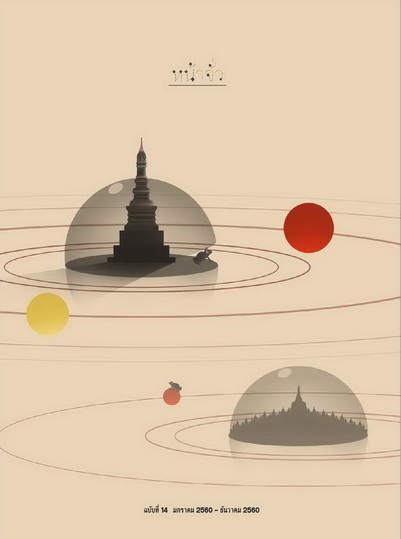การค้าทางทะเลกับเครือข่ายของศิลปะ : ข้อมูลจากการศึกษาโบราณสถานและประติมากรรมที่ไชยา/ Maritime Trade and Networks of Arts: Reflections on Buddhist Monuments and Statues in Chaiya
Main Article Content
Abstract
บทคัดย่อ
อายุสมัยและรูปแบบศิลปะของวัดแก้ว วัดหลง วัดพระบรมธาตุไชยา รวมถึงพระโพธิสัตว์สำริดสมัยศรีวิชัยที่อำเภอไชยา จังหวัดสุราษฎร์ธานี ถือได้ว่ามีข้อถกเถียงมาอย่างยาวนานพอควร ทั้งนี้เป็นผลมาจากความแตกต่างทางความคิดของนักวิชาการและข้อจำกัดจากหลักฐาน โดยเฉพาะไม่พบจารึกร่วมกับโบราณสถานและประติมากรรม ที่ต้องทบทวนอายุสมัยของโบราณสถานและประติมากรรมที่ไชยาอีกครั้งเพื่อให้ได้ค่าอายุที่ชัดเจน ซึ่งจะส่งผลต่อการอธิบายการเคลื่อนไหวของศาสนาพุทธมหายาน และประวัติศาสตร์เครือข่ายการค้าของชุมชนทั้งในไชยา รัฐต่าง ๆ ในเอเชียตะวันออกเฉียงใต้ และอินเดีย บทความนี้มีวัตถุประสงค์ 3 ประการหลักคือ ประการแรก ทบทวนอายุสมัยของโบราณสถานและประติมากรรมในไชยา ประการที่ 2 เพื่อศึกษาเครือข่ายศาสนาและการค้าระหว่างศรีวิชัยที่ไชยากับอินเดียและรัฐต่าง ๆ ในเอเชียตะวันออกเฉียงใต้ ประการที่ 3 เพื่อเข้าใจนัยยะทางสังคมจากสิ่งที่บทความนี้เรียกว่า ศิลปะผสม (heterogeneous art) ที่ปรากฏชัดในโบราณสถาน
ผลจากการศึกษาพบว่า ทั้งโบราณสถานและประติมากรรมที่ไชยาควรจะกำหนดอายุอยู่ในช่วงประมาณปลายคริสต์ศตวรรษที่ 8 ถึงต้นคริสต์ศตวรรษที่ 9 ซึ่งจะสอดคล้องกับจารึกวัดเสมาเมือง (ค.ศ. 775/ พ.ศ. 1318) ดังนั้นอายุสมัยของโบราณสถานและประติมากรรมควรอยู่ในช่วงเวลาเดียวกับจารึก ไม่ใช่หลังจากนั้นดังที่นักวิชาการบางท่านเสนอ ในแง่ของรูปแบบศิลปะพบว่ามีความสัมพันธ์กับรัฐต่าง ๆ ได้แก่ จาม ชวา ปาละ และโจฬะ สะท้อนให้เห็นถึงเครือข่ายทางการค้าทางทะเลที่กว้างขวาง ซึ่งทำให้ศิลปะและศาสนาเคลื่อนย้ายไปตามกลุ่มคน โดยพื้นที่ไชยาเป็นเสมือนกับพื้นที่กลางระหว่างตะวันตกกับตะวันออก ทำให้เป็นเบ้าหลอมของศิลปะที่กลายเป็นศิลปะผสม ในขณะเดียวกันก็สะท้อนให้เห็นว่าศิลปะบนโบราณสถานได้กลายเป็นพื้นที่ของการปะทะสังสรรค์ที่สะท้อนอัตลักษณ์ของศาสนิกชนที่มีทั้งประชาชนในท้องถิ่น พ่อค้า พระ และอื่น ๆ จากต่างแดน
Abstract
The dating and art style of Wat Kaew, Wat Long, Wat Praboromathat Chaiya and the Bodhisattva statues of Srivijaya in Chaiya, Southern Thailand, have long been debated among scholars. This problem is very important because of its influence on our understanding of the Buddhist esoteric (Tantric) movement and the early history of Srivijaya on the Malay Peninsula and in Southern Thailand. This study has three aims: firstly, to examine the dating of monuments and statues found in Chaya; secondly, to better understand religious pilgrimage and trade networks as well as social contacts between Srivijaya in Chaiya, India, and other kingdoms of ‘Southeast Asia’; thirdly, to discuss the heterogeneous art styles of the monuments of Chaiya.
The results of this research suggest that the art style of monuments and statues in Chaiya should be dated to approximately the late eighth to the early ninth century, which coincides with one inscription dated to 775 AD. The art style of the ‘Chaiya school’ is associated with Cham, Java, Pala and Chola art; this can be called heterogeneous art. The creation of heterogeneous art is associated with Chaiya’s status as a port city and transpeninsular bridge, which meant that shared monuments were necessary for merchants waiting for the monsoon. The art elements appearing on architecture and statues from various sources represent the unique style of each kingdom or community, relating to the exchange of arts, artisans, and priests between them. Three brick monuments in particular show the origins of artistic influences and a combination of discernibly different art styles, and considering the fact that each art style represented the identity of each kingdom, the different elements should represent the communities that donated funds for the monuments’ construction.


